Detroit Metropolitan Airport
Detroit Metropolitan Wayne County Airport (IATA: DTW, ICAO: KDTW, FAA LID: DTW), usually called Detroit Metro Airport, Metro Airport, or just DTW, is a major international airport in the United States covering 4,850 acres (1,960 ha)[3] in Romulus, Michigan. It is the primary international airport serving Detroit and is Michigan's busiest airport. The Federal Aviation Administration (FAA) National Plan of Integrated Airport Systems for 2017–2021 categorized it as a large hub primary commercial service facility.[3]
Detroit Metropolitan Wayne County Airport | |||||||||||||||||||||||||||||||
|---|---|---|---|---|---|---|---|---|---|---|---|---|---|---|---|---|---|---|---|---|---|---|---|---|---|---|---|---|---|---|---|
 | |||||||||||||||||||||||||||||||
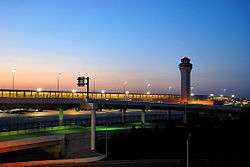 | |||||||||||||||||||||||||||||||
| Summary | |||||||||||||||||||||||||||||||
| Airport type | Public | ||||||||||||||||||||||||||||||
| Owner | Wayne County, Michigan | ||||||||||||||||||||||||||||||
| Operator | Wayne County Airport Authority | ||||||||||||||||||||||||||||||
| Serves | Detroit, Michigan, United States, Ann Arbor, Michigan, United States and Windsor, Ontario, Canada | ||||||||||||||||||||||||||||||
| Location | Romulus, Michigan, United States | ||||||||||||||||||||||||||||||
| Hub for | Delta Air Lines[1] | ||||||||||||||||||||||||||||||
| Focus city for | Spirit Airlines | ||||||||||||||||||||||||||||||
| Elevation AMSL | 645 ft / 197 m | ||||||||||||||||||||||||||||||
| Coordinates | 42°12′45″N 083°21′12″W | ||||||||||||||||||||||||||||||
| Website | www | ||||||||||||||||||||||||||||||
| Maps | |||||||||||||||||||||||||||||||
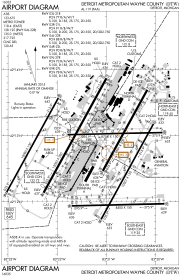 FAA diagram | |||||||||||||||||||||||||||||||
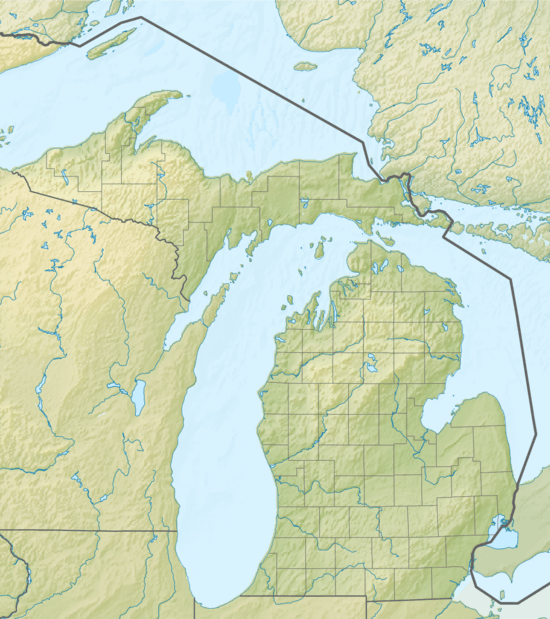 DTW  DTW | |||||||||||||||||||||||||||||||
| Runways | |||||||||||||||||||||||||||||||
| |||||||||||||||||||||||||||||||
| Statistics (2019) | |||||||||||||||||||||||||||||||
| |||||||||||||||||||||||||||||||
Source: Detroit Metropolitan Airport[2] | |||||||||||||||||||||||||||||||
The airport is a major hub for Delta Air Lines and is also a base for Spirit Airlines.[4][5] Detroit serves as Delta's main gateway to Asia for the Eastern United States. The airport has service to 30 international destinations and service to 39 states across the United States. Operated by the Wayne County Airport Authority, the airport has six runways, two terminals and 129 in-service gates.[6] Detroit Metropolitan Airport has maintenance facilities capable of servicing and repairing aircraft as large as the Boeing 747-400.[7]
Metro Airport serves the Metropolitan Detroit area, the Toledo, Ohio area, about 40 miles (64 km) south, the Ann Arbor area to the west, and Windsor, Ontario and Southwestern Ontario in Canada.[8] The airport serves over 140 destinations[6] and was named the best large U.S. airport in customer satisfaction by J.D. Power & Associates in 2010 and 2019.[9][10]
History
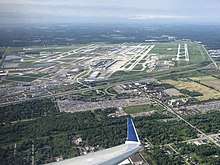
Wayne County began to plan an airport in the western townships of the county as early as 1927. The following year the county board of commissioners issued a $2 million bond to fund the purchase of one square mile (2.6 km2) of land at the corner of Middlebelt and Wick roads, the northeastern boundary of today's airport. Construction was completed in 1929, and the first landing was on February 22, 1930; Wayne County Airport was dedicated on September 4, 1930.[11] That year Thompson Aeronautical Corporation, a forerunner of American Airlines, began service from the airport. From 1931 until 1945 the airport hosted Michigan Air National Guard operations gained by the United States Army Air Forces. It was named Romulus Field during the war; it was then all east of Merriman Road and north of Goddard Road. The intersection of the two runways is still visible at 42.23266°N 83.33564°W.
Wayne County expanded the airport to become Detroit's primary airport. It renamed it Detroit-Wayne Major Airport in 1947, and in the next three years expanded threefold as three more runways were built. In 1949 the airport added runways 3L/21R and 9L/27R, followed by runway 4R/22L in 1950. In 1946-47 most airline traffic moved from the cramped Detroit City Airport (now Coleman Young International Airport) northeast of downtown Detroit to Willow Run Airport over 20 miles (32 km) west of the city, and 10 miles (16 km) west of Wayne County Airport.
Pan-Am (1954) and BOAC (1956) were the first passenger airlines at Detroit-Wayne Major. In the April 1957 Official Airline Guide they were the only passenger airlines: three Pan Am DC-7Cs each week FRA–LHR–SNN–DTW–ORD and back, and one BOAC DC-7C each week LHR–PIK–YUL–DTW–ORD and back (skipping YUL on the return flight).
Aerial photographs of DTW from 1949 and 1956 show the airport's expansion.[12] In 1958 the Civil Aviation Administration—now the Federal Aviation Administration (FAA)—announced the inclusion of Detroit-Wayne in the first group of American airports to receive new long-range radar equipment, enabling the airport to become the first inland airport in the United States certified for jet airliners. Also in 1958, airport management completed the L.C. Smith (South) Terminal and gave the airport its present name.[13]
American Airlines moved from Willow Run to Detroit-Wayne in October 1958, followed by Northwest, Allegheny and Delta in the next few months; the other airlines stayed at Willow Run until 1966. Northwest's flights to Minneapolis were DTW's only nonstops west beyond Chicago and Milwaukee until 1966. The first scheduled jets were Delta DC-8s to Miami in late 1959. The North Terminal (later renamed the Davey Terminal) opened in 1966 and a third terminal, the Michael Berry International Terminal, opened in 1974. The last of its original three parallel runways (3R/21L) was completed in 1976; a new parallel crosswind runway (9R/27L) opened in 1993.
Republic Airlines began hub operations in 1984,[14] and its merger with Northwest Airlines in 1986 expanded the hub. Transpacific flights began in 1987, with Northwest providing nonstop service to Tokyo.[15] The last of Metro's six runways (4L/22R) was completed in December 2001 in preparation for the opening of the mile-long, 122-gate, $1.2 billion McNamara Terminal in the airport midfield in 2002.[13] The airport remained a hub for Northwest Airlines until it merged with Delta Air Lines.[16]

The present Runway 3L/21R has had four identifiers. When opened in 1949, it was Runway 3/21. With the opening of the new west side Runway 3L/21R in 1950, the original 3/21 became 3R/21L. With the opening of the new east side Runway 3R/21L in 1976, it became 3C/21C. With the opening of Runway 4L/22R in December 2001 and the splitting of the field into two sectors (3/21 on the east and 4/22 on the west), Runway 3C/21C became Runway 3L/21R.
In 2009, Detroit Metro Airport launched its first social media efforts with participation in Twitter, Facebook, and YouTube networks.
Detroit was a major hub for Northwest Airlines from 1986 to 2010; Northwest merged with Delta Airlines, and Detroit became Delta's second largest hub.
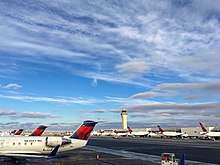
In April 2011 Lufthansa launched a unique curbside check-in and baggage check service for premium customers from DTW's North Terminal to Frankfurt and beyond. Lufthansa became the only airline allowing international customers departing from DTW to check their bags and receive a boarding pass at the curb, while DTW becomes Lufthansa's first North American gateway with this service.[17]
Detroit's economy plunged in the Great Recession, causing airlines such as British Airways to drop flights to London–Heathrow and other airlines such as KLM Royal Dutch Airlines and Virgin Atlantic to use codeshare flights through Delta Air Lines. The city has lost population, but Detroit Airport has since re-grown, and airlines are looking to expand or resume service. JetBlue Airways began flights to Boston in February 2014. United Airlines resumed nonstop flights to San Francisco in June 2017 in efforts to boost competition in Detroit. Spirit Airlines has grown at Detroit, adding service to more East and West Coast cities. Spirit has increased their market share to over 10%, widening the gap as Metro Airport's 2nd largest carrier.[18]
Royal Jordanian was the first airline to schedule the Boeing 787 Dreamliner into Detroit, on December 1, 2014.[19]
One of Delta Connection carriers, Compass Airlines chose to close its operating base in Detroit to move operations to the new Seattle hub in early 2015. Delta has replaced many of the existing Compass flights with mainline Delta flights to allow SkyWest Airlines and GoJet to open Detroit bases.[20]
Beginning in January 2018 Suburban Mobility Authority for Regional Transportation, or SMART Bus, began providing a direct connection from the airport to the Rosa Parks Transit Center in downtown Detroit via route 261, also known as the Michigan Ave FAST bus, with stations at both the McNamara and North terminals.[21]
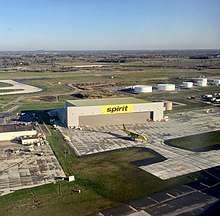
On June 26, 2015 Spirit Airlines announced the construction of a new maintenance facility, saying it would bring $31.5 million and 82 jobs to the area. Spirit Airlines had a hangar that closed, forcing the airline to do maintenance at the gate with contract workers. With the new facility, which opened in May 2017, Spirit will retain its operating base at Metro Airport, and bring more flights.[22] Spirit was also the first airline to regularly fly the A320neo in the US, the first route was Detroit to Los Angeles as well as add self-tagging luggage kiosks at DTW.
In 2017, WOW Air announced service to Reykjavik on the Airbus A321. This marked the first ever entrance of a modern European low-cost carrier to DTW. In summer of 2018, Reykjavik went from the 55th most traveled destination to 5th due to this flight's popularity. Passengers could connect in Reykjavik, boosting travel to European destinations. In March 2019, the airline ceased operations, leaving Metro Airport with no low-cost nonstop to Europe; the airport is looking for replacement service to begin in 2020.[23]
Future
The Airport Authority's long-term plans include a bus transportation system to a light rail station north of the airport proposed by the RTA, expansions and re-surfacing of runways to accommodate the Airbus A380, as well as vendor, security checkpoint and terminal expansions. The bus route would connect the existing terminals to a light rail station north of the airport via bus with an anticipated consolidated rental car facility and a planned regional rail system.
Also, the airport is considering the expansion of both ends of Concourse D as well as expand or relocate security checkpoints to meet tomorrow's travel needs. There are several options for the expansion of the North Terminal to meet the demands of airlines, which include expanded ticket counter space, expanded or centralized security, and the option of expanding the north or south ends of the terminals to add an additional 5 gates. The McNamara terminal includes expanded ticket counter space, centralized security and node upgrades or expansions in Concourse C.[24]
Goals are to include better connectivity to the Middle East, India, and nonstop flights to several key destinations in Europe, Latin America, and Asia.[25] This addition would add to the airport's four existing parallel runways and its two crosswind runways in order to alleviate future congestion.[26]
The Regional Transit Authority is planning mass transit from Detroit to a rail connection point just north of the airport, in an effort to make transportation quicker and easier.[27] The planned SEMCOG Commuter Rail system, with terminals at Ann Arbor and Detroit, would stop at the airport and provide rail transportation to and from the city.[28] Because the line will use existing infrastructure, it will not directly serve the airport, but connect via shuttle. The planned airport station will be approximately 5 miles (8.0 km) north of the airport. Whether the RTA or SEMCOG plan ends up being adopted is still unclear.
According to the most recent version of the master plan, the current FAA tower will be replaced with a new tower located near the site of the demolished Smith Terminal. Recent findings of mold and other fungi inside the current tower have accelerated the current towers useful life, allowing the FAA to plan construction of the new tower once the final phase of the former Smith terminal completes demolition.[29]
Facilities
Edward H. McNamara Terminal
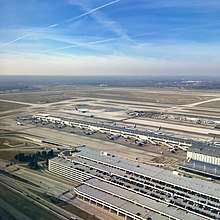
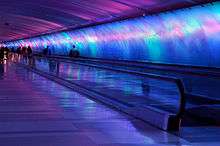
DTW has 4 concourses with a total of 129 gates. The McNamara Terminal, also once known as the Northwest WorldGateway, opened February 25, 2002. Designed by SmithGroup and built by Hunt Construction Group, it replaced the aged Davey Terminal. During development, the terminal was known as the Midfield Terminal.[13] The terminal is used exclusively by Delta (which merged with Northwest), and Delta partners Aeromexico and Air France. This terminal has three concourses, A, B, and C, which house 103 gates with shopping and dining in the center of A concourse (known as the Central Link), as well as throughout the concourses. It houses three Delta Skyclubs located throughout Concourse A, and 1 located in Concourses B and C. At nearly 1 mi (1.6 km) in length, Concourse A in McNamara Terminal is the second-longest airport concourse in the world (the longest is in Terminal 1 of Kansai International Airport in Japan).[30][31] In addition to moving walkways spaced along the length of each concourse, Concourse A has a people mover, the ExpressTram. It transports passengers between each end of Concourse A in just over three minutes. Trams arrive almost simultaneously at the Terminal Station, in the midpoint of the concourse and depart in opposite directions to the North Station and the South Station, then return.[32] The McNamara Terminal opened a new baggage sorting facility in October 2008, which has improved the screening of baggage through 14 new explosive detection system devices along a fully automated conveyor system. Northwest Airlines said that it reduced the amount of lost baggage, and it improved the timeliness of bags getting to their correct flight.[33][34]
An AAA Four Star Westin hotel is connected to the A concourse. Additionally, overnight guests at the hotel who are not flying can obtain a pass to enter the concourses to visit shops and restaurants. Called the Airport Access Authorization to Commercial Establishments Beyond the Screen Checkpoint (AAACE), registered guests must be cleared through the same security background check (Secure Flight) and TSA screening process as travelers to access the terminal area. Dallas-Fort Worth International Airport is the only other airport participating in this program.[35]
The A concourse houses 62 gates with 12 gates used for international departures and arrivals processing.[32] The A concourse is intended for all aircraft. At the midpoint of the concourse is a large, laminar flow water feature designed by WET.[36] The concourse contains over 1.5 miles (2.4 km) of moving walkways. The A concourse also includes a pet relief area for passengers traveling with pets and service animals. Signage through the terminal is in English, along with Japanese due to the large number of business travelers from Japan. Izumi Suzuki, a Sheraton employee, and several colleagues provided the Japanese translations used by the airport. In previous eras many Japanese travelers going through Detroit missed connections due to a lack of English comprehension.[37] Also, messages reminding travelers to configure watches to the Eastern Time Zone regularly broadcast through the public address system are said in English, Japanese, and Mandarin.
In addition to the ticketing level, there's an additional ticketing and security area for passengers using the parking structures.
The terminal houses ten international gates that are capable of dual jet bridge loading and unloading. The gates contain two exit configurations depending on the arriving flight. Domestic arrivals follow an upper path directly into the terminal while international arrivals proceed downstairs to customs and immigration screening. The Customs and Border Protection processing center located in the terminal's lower level is designed to accommodate as many as 3,200 passengers per hour. International arriving passengers connecting to another flight are screened by TSA at a dedicated screening checkpoint within the international arrivals facility. Those passengers then exit directly back into the center of the A concourse.[38] Passengers arriving from international destinations who end their trip in Detroit (or connecting to a flight via North Terminal) exit directly into a dedicated International Arrivals Hall on the lower level of the terminal.
The B and C concourses currently have 41 gates that are used for Delta's regional flights that employ smaller aircraft. All regional flights have jet bridges, eliminating the need for outdoor boarding.
The B and C concourses are connected to the main terminal building and the A concourse by a pedestrian walkway under the Airport ramp. This walkway, known as the Light Tunnel, features an elaborate multi-colored light show behind sculpted glass panels extending the entire length of the walkway, as well several moving walkways. The light patterns are synchronized with an original musical score composed by Victor Alexeeff,[39] which runs for nearly 30 minutes before repeating. This installation, one of the first large-scale uses of color changing LED lighting in the United States, was produced by Mills James Productions with glasswork by Foxfire Glass Works of Pontiac, Michigan. The display won multiple lighting design awards including the prestigious Guth Award of Merit. For passengers who are prone to medical conditions such as seizures, there are buttons at each end of the tunnel that will suspend the light show for five minutes so they can pass through with no adverse effects.
The terminal has undergone updates that include new electronic terminal directories to better assist passengers. A unique feature of this is that passengers can scan their boarding passes, and the screen will direct them to the gate from which their plane departs. The passenger can also choose to view the information in other languages. Passengers may select a restaurant on the touch screen and a menu will show what items the restaurant serves. Mini tablet devices and phone/tablet apps have been installed in food court areas, where travelers may order food and have it delivered to their table.[40]
There are four Delta Sky Clubs located in the McNamara terminal. The largest is located above the central link across from gate A38. There are two satellite Sky Clubs in Concourse A located on the upper level near gates A18 and A68, across from their respective ExpressTram stations. An additional Sky Club is located in Concourse C, at gate level near the entrance to Concourse C. This lounge services Delta Connection flights in concourses B & C.[41]
North Terminal
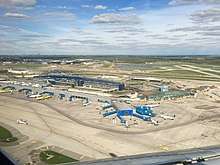
The North Terminal, designed by Gensler and built by Walbridge/Barton Malow Joint Venture,[42] opened September 17, 2008, as the replacement for the aged Berry and Smith terminals, which housed all non-SkyTeam airlines. Initially, Wayne County Airport Authority sought bids for the naming rights of the North Terminal. After two years with no successful offers, however, the effort ceased and the North Terminal name remained.[43]
The terminal currently houses all non-SkyTeam airlines serving the airport, and is considered D Concourse. (Concourses A, B, and C are housed in the McNamara Terminal) The concourse has 26 gates, two of which opened in the middle of 2009 to accommodate international wide-body aircraft. The two gates were unusable at the building's opening because they were extremely close to Smith Terminal's C concourse, which was demolished after operations moved to the new facility. The terminal features four long segments of moving walkways on the departures level, and another moving walkway on the lower level; that is for international arriving passengers to access the Federal Inspection Services area.
Airlines that utilize the North Terminal include Air Canada, Alaska, American, American Eagle, Frontier, JetBlue, Lufthansa, Royal Jordanian, Southwest, Spirit, United, United Express, and all non-SkyTeam and non-Delta partner charters.
The North Terminal houses two six-lane security checkpoints. The terminal also has U.S. Customs & Border Protection inspection facilities located on the lower level for arriving international flights.[44]
The North Terminal includes a Lufthansa club, located at the south end of the D Concourse near gate D4. Also, this terminal includes a brand new service pet relief area to accommodate passengers traveling with pets.
The North Terminal has five common-use domestic baggage carousels on the lower level. Two additional carousels are located inside the Federal Inspection Services area for international flights, and a central Oversize Baggage Claim is adjacent to both the international and domestic carousel areas.
January 29, 2010, the North Terminal was named winner of the "Build Michigan" award project.[45]
The North Terminal is home to a Lufthansa Business and Senator Lounge located between Gates 7 & 8. This lounge is accessible to passengers flying in Lufthansa premium cabins as well as select Lufthansa and Star Alliance elite members. This lounge also grants access to Priority Pass members outside of peak hours.[46]
Historical terminals
Michael Berry Terminal
The Berry Terminal, named for a former airport commissioner, was designed by Detroit architect Louis G. Redstone, and opened in 1974 as the international terminal at DTW. It was decommissioned on September 17, 2008, and replaced by the North Terminal. All international passengers would arrive at this terminal, pass through customs and immigration inspection, and continue on to their connecting flights by bus to adjacent terminals. Originally containing six gates (two of which were removed in 2003 to allow for construction of an adjacent Northwest Airlines maintenance hangar), the terminal was later used for scheduled and charter flights. There were still several international scheduled flights on low cost carriers to destinations in the Caribbean and other warm-weather destinations in the early 2000s, including flights from Champion Air, Ryan International Airlines and USA3000 Airlines. Four charter airlines also used this terminal. Since its closure in 2008, the Berry Terminal was a popular space for commercial film and television production. Films such as Up in the Air (2009), Machine Gun Preacher (2011) and This Must Be the Place used the vacant terminal as a set (in addition to shooting in and around the airport's active terminals). March 31, 2015, the board announced that it would seek bids to demolish the Berry terminal.[69] On April 16, 2015, the board announced it would construct a new facility for its offices that it would name after Michael Berry. It expected the new structure to open in 2017. The Berry Terminal was demolished between December 2017 and January 2018.
L. C. Smith Terminal
The Smith Terminal, named for Detroit-Wayne Major airport visionary Leroy C. Smith, was built in 1958. Though cited as the oldest of Metro Airport's terminals, that designation belongs to the Executive Terminal building located near Middlebelt Road and Lucas Drive, one-quarter-mile east. The Executive Terminal was built in 1938 and is still in operation today as home to ASIG, a flight support company. The Smith Terminal's 32 gates originally housed Allegheny Airlines (forerunner to US Airways), American Airlines, BOAC, North Central Airlines, Northwest Orient Airlines, and Pan Am, among others. The facility included a control tower which served its purpose until the late 1980s, when the airport constructed a new control tower near the McNamara Terminal. In later years, Smith Terminal hosted North American airlines other than Northwest, Continental, and later Delta, which relocated to the McNamara Terminal in 2002 before its merger with Northwest. State of the art for its time, the Smith Terminal eventually became victim to airline expansion. The design of the building did not allow for physical expansion of the ticketing area. To accommodate additional airlines, ticketing counters were constructed on the sides of the lobby in areas that previously held lounges and retail. In contrast, the North Terminal was constructed with future expansion in mind. Spirit Airlines, which operated out of many of the gates once used by Northwest, made few upgrades to the gate areas in those parts of the terminal. The Northwest Airlines display boards near check-in counters at each gate remained in place, with the Northwest logos removed, and a Spirit information board simply affixed over the old signage. On September 10, 2008, The Detroit News reported that Smith Terminal itself will not be demolished because the airport authority offices remain on the upper floors. However, the Detroit Free Press of October 9, 2008, stated that maintaining the terminal in its present condition would cost upwards of $4 million annually in utilities, a sore spot for airlines at DTW who foot the bill, in part, through airport landing fees; the airlines were hoping for a greater cost savings once the Smith and Berry terminals were decommissioned. On May 20, 2009, the airport authority formally voted to totally vacate the Berry Terminal, while using the L.C. Smith Terminal for its offices. The Airport Authority also held discussions regarding of a new structure to house its offices and Airport Police, with a preliminary price tag of $31.5 million. As of May 2018, preliminary plans have begun to demolish the Smith Terminal as part of the new Runway 3L project. The Smith Terminal area will be used for a De-ice pad for the 3L runway project.
James M. Davey Terminal
The Davey Terminal was built in 1966 and was first known as "Terminal 2" or the "North Terminal". Designed by the firm of Smith, Hinchman and Grylls, it was said to be the largest post tensioned building in the world. Tapering cruciform columns around the perimeter and curved beams supported five large concrete roof panels. The lack of columns allowed maximum flexibility in the interior space. The spaces between the roof panels and exterior columns were filled with glass to allow abundant natural light into the building. It was renamed the "J. M. Davey Terminal" in 1975 in honor of former airport manager James M. Davey. It originally contained three concourses labeled D to F, as well as a Host Hotel which later was rebranded Marriott. In the early 1980s, a separate ticketing area was constructed to the north of the Davey Terminal for international departures, along with Concourse G to accommodate Northwest Airlink's regional fleet. Concourse C, originally part of the Smith Terminal, became to be considered part of the Davey Terminal once Northwest Airlines began to use it in the 1990s. Over time, the terminal and added concourse began showing its age due to its layout and poor maintenance, hastened further by increased aircraft traffic, which it was not designed to handle efficiently. Despite this, more gates were added to Concourse C in a short-term expansion project in the early 1990s, making it 26 gates in length. This concourse was considered the worst by most travelers due to its long distance from the center of the terminal, and for its length. The Davey Terminal was originally the principal base of operations for Republic Airlines, which merged with Northwest Orient Airlines to become Northwest Airlines in 1986. Upon relocation of Northwest operations to the McNamara Terminal, the Davey Terminal was mothballed for three years before demolition of the ticketing area and Concourse G began October 17, 2005, to prepare for the North Terminal project. All concourses of the Davey Terminal and adjoining Marriott hotel, except gates 1 to 11 of Concourse C, were subsequently demolished in 2005–06 (the remaining gates were in use by Spirit Airlines until the new North Terminal opened on September 17, 2008, during this time these gates on C were accessed through the Smith Terminal, as originally intended).
Ground transportation
The airport is accessible from Interstate 94 (I-94) by taking exit 198 to Merriman Road, which is the closest entrance to the North Terminal, and from I-275 via Eureka Road, which is closer to the McNamara Terminal. John D. Dingell Drive, named after long-time Congressman, is an expressway built in 1999 to access the McNamara Terminal and connects the I-94 and Eureka Road entrances of the airport.[47]
The Suburban Mobility Authority for Regional Transportation, or SMART, operates bus route 261 (FAST Michigan), a limited-stop service that connects both the McNamara and North Terminals to the Rosa Parks Transit Center in downtown Detroit and points in between for $2.00 one-way every 30 minutes.[48][49]
The Michigan Flyer provides bus service between the airport and Ann Arbor, Brighton, and East Lansing eight times daily.
Terminal To Terminal shuttles provide free transport between the McNamara and North Terminals. Robert Q. Airbus also provides independent shuttle services to destinations in Southern Ontario, and most hotels located within the airport perimeter provide their own shuttle services as well.
The McNamara and North Terminals also have cell phone lots.[50]
Airlines and destinations
Passenger
Cargo
| Airlines | Destinations |
|---|---|
| Atlas Air | Cincinnati |
| FedEx Express | Columbus–Rickenbacker, Indianapolis, Memphis, Newark |
| Kalitta Air | Cincinnati, Minneapolis/St. Paul |
| UPS Airlines | Chicago/Rockford, Philadelphia |
| Western Global Airlines | Louisville |
Statistics
Top destinations
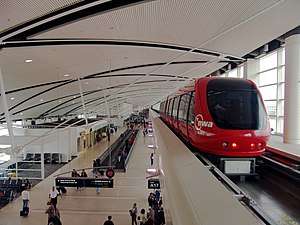
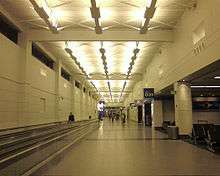
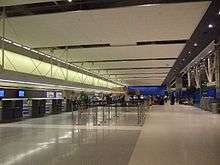
| Rank | City | Passengers | Carriers |
|---|---|---|---|
| 1 | Atlanta, Georgia | 598,000 | Delta, Spirit |
| 2 | Orlando, Florida | 537,000 | Delta, Frontier, Southwest, Spirit |
| 3 | Las Vegas, Nevada | 450,00 | Delta, Frontier, Southwest, Spirit |
| 4 | Denver, Colorado | 393,000 | Delta, Frontier, Southwest, Spirit, United |
| 5 | New York–LaGuardia, New York | 386,000 | American, Delta, Spirit |
| 6 | Los Angeles, California | 385,000 | Delta, Spirit |
| 7 | Chicago–O'Hare, Illinois | 382,000 | American, Delta, United |
| 8 | Dallas/Fort Worth, Texas | 380,000 | American, Delta, Spirit |
| 9 | Boston, Massachusetts | 360,000 | Delta, JetBlue, Spirit |
| 10 | Fort Lauderdale, Florida | 355,000 | Delta, Spirit |
| Rank | Airport | Passengers | Carriers |
|---|---|---|---|
| 1 | Amsterdam, Netherlands | 600,602 | Delta |
| 2 | Paris–Charles de Gaulle, France | 363,452 | Air France, Delta |
| 3 | Frankfurt, Germany | 309,630 | Delta, Lufthansa |
| 4 | Toronto–Pearson, Canada | 299,586 | Air Canada, Delta |
| 5 | Cancún, Mexico | 248,946 | Delta, Spirit |
| 6 | Seoul–Incheon, South Korea | 203,260 | Delta |
| 7 | Tokyo–Narita, Japan | 192,902 | Delta |
| 8 | Shanghai–Pudong, China | 190,842 | Delta |
| 9 | London-Heathrow, United Kingdom | 183,174 | Delta |
| 10 | Beijing-Capital, China | 178,328 | Delta |
Airline market share
| Rank | Airline | Passengers | Percent of market share |
|---|---|---|---|
| 1 | Delta Air Lines | 15,704,000 | 48.89% |
| 2 | SkyWest Airlines | 4,129,000 | 12.86% |
| 3 | Spirit Airlines | 3,426,000 | 10.67% |
| 4 | Endeavor Air | 1,948,000 | 6.06% |
| 5 | Southwest Airlines | 1,438,000 | 4.48% |
Annual traffic
| Year | Passengers | Year | Passengers | Year | Passengers |
|---|---|---|---|---|---|
| 1995 | 28,298,215 | 2005 | 36,383,514 | 2015 | 33,440,112 |
| 1996 | 27,408,666 | 2006 | 35,972,673 | 2016 | 34,401,254 |
| 1997 | 30,732,871 | 2007 | 36,013,478 | 2017 | 34,701,497 |
| 1998 | 30,803,158 | 2008 | 35,135,828 | 2018 | 35,236,676 |
| 1999 | 33,967,819 | 2009 | 31,357,388 | 2019 | 36,769,279 |
| 2000 | 35,535,080 | 2010 | 32,377,064 | ||
| 2001 | 32,631,463 | 2011 | 32,406,159 | ||
| 2002 | 32,477,694 | 2012 | 32,242,473 | ||
| 2003 | 32,738,900 | 2013 | 32,389,544 | ||
| 2004 | 35,229,705 | 2014 | 32,513,555 |
Accidents and incidents
- December 30, 1964, a Zantop Air Transport C-46 Commando with 4 occupants crashed 2.2 miles SW of DTW, killing all aboard. A loss of control during a night instrument approach in adverse weather was the probable cause.[70]
- June 12, 1972, after a stopover in Detroit, American Airlines Flight 96, a McDonnell Douglas DC-10-10 with 56 passengers and 11 crew from Los Angeles International Airport en route to Buffalo, New York, suffered a cargo door failure and explosive decompression shortly after departure from Detroit Metropolitan Airport while flying over Windsor, Ontario. It is thus sometimes referred to as the Windsor incident.[71] The aircraft sustained damage that left the pilots without full flight controls but the plane returned to Detroit for a successful emergency landing. There were no fatalities but several serious to minor injuries.
- July 31, 1972, Delta Air Lines Flight 841; members of the Black Liberation Army took over the airplane in flight using weapons smuggled on board, including a Bible cut out to hold a handgun. The plane held 7 crew and 94 passengers, none of whom was killed during the hijacking. Five hijackers who had boarded with three children took over the plane. The plane flew to Miami where the passengers were exchanged for $1 million in ransom. The plane was then flown on to Boston where it refueled before flying to Algeria. Algeria seized the plane and ransom, which they returned to the U.S. but the hijackers were released after a few days.
- December 15, 1972, a Zantop International Airlines Learjet 23, a ferry flight, crashed after failing to climb from runway 3R, hitting a fuel storage tank. Both occupants on board and 1 on the ground were killed. Cause undetermined.[72]
- January 11, 1983, a United Airlines McDonnell Douglas DC-8F, a cargo flight with 3 occupants aboard crashed after takeoff due to a mistrimmed stabilizer causing a loss of control, all on board were killed.[73]
- March 4, 1987, Northwest Airlink Flight 2268, operated by Fischer Brothers Aviation, a CASA 212 was on a scheduled flight from Mansfield to Detroit with an intermediate stop in Cleveland when it crashed while landing at Detroit Metropolitan Wayne County Airport. The plane yawed violently to the left about 70 feet (21 m) above the runway, skidded to the right, hit three ground support vehicles in front of Concourse F and caught fire. Of 19 occupants onboard (16 passengers and 3 crew), 9 were killed. The cause of the crash was determined to be pilot error.[74]
- August 16, 1987, a McDonnell Douglas MD-82 operating as Northwest Airlines Flight 255,[75] bound for Phoenix, Arizona, crashed on take-off from Metro's 8,500-foot-long (2,600 m) Runway 3 Center (Now Runway 3L). All but one passenger on the aircraft were killed; the lone survivor was a young girl, Cecelia Cichan, who lost both of her parents and her brother. The NTSB determined that the accident resulted from flight crew's failure to deploy the aircraft's flaps prior to take-off, resulting in a lack of necessary lift. The aircraft slammed into an overpass bridge on I-94 just northeast of the departure end of the runway.[76]
- December 3, 1990, a McDonnell Douglas DC-9-14 operating as Northwest Airlines Flight 1482, bound for Pittsburgh, collided with a Boeing 727-200 Adv. operating as Northwest Airlines Flight 299, bound for Memphis, on runway 03C. Seven passengers and a flight attendant on Flight 1482 were killed. The cause of the accident is listed as "pilot error".[77][78]
- January 9, 1997, an Embraer EMB 120 Brasilia aircraft operating as Comair Flight 3272 crashed nose down 18 miles (29 km) from the airport while on approach into Detroit. All 26 passengers and 3 crew members were killed. The cause is listed to be the "FAA's failure to establish adequate aircraft certification standards for flight in icing conditions, the FAA's failure to ensure that an FAA/CTA-approved procedure for the accident airplane's deice system operation was implemented by U.S.-based air carriers, and the FAA's failure to require the establishment of adequate minimum airspeeds for icing conditions."[79]
- December 25, 2009, Nigerian national Umar Farouk Abdulmutallab attempted to detonate an explosive device on Northwest Airlines Flight 253, an Airbus A330 from Amsterdam to Detroit as the plane was approaching Detroit. The device failed to go off correctly, and the suspect suffered burns to his lower body. Three other passengers had minor injuries. The White House said it considered the incident an attempted terrorist attack.[80]
See also
References
![]()
- "Detroit Metropolitan Wayne County Airport - Delta News Hub". news.delta.com. Archived from the original on December 7, 2017. Retrieved November 27, 2017.
- "Airport Statistics 2018". Wayne County Airport Authority. 2018. Archived from the original on December 30, 2018. Retrieved February 4, 2019.
- "FAA Airport Master Record for DTW" (PDF). Retrieved November 20, 2019.
- "Detroit Metropolitan Wayne County Airport". Delta News Hub. Archived from the original on January 7, 2016. Retrieved January 13, 2016.
- "Annual Report for the period ending 12/31/11" (PDF). Spirit Airlines. February 23, 2012. Archived from the original (PDF) on October 2, 2013. Retrieved January 10, 2013.
- "Press Room: Facts". Wayne County Airport Authority. Archived from the original on January 20, 2013. Retrieved January 10, 2013.
- "Detroit Metropolitan Airport, Twin Bay Boeing 747 Hangar". Walbridge Construction. Archived from the original on July 13, 2013. Retrieved January 10, 2013.
- "Travel Tips & Security Information: FAQ-Directions". Wayne County Airport Authority. Archived from the original on February 24, 2009. Retrieved January 10, 2013.
- Pawlowski, Agnes (February 24, 2010). "Detroit Tops Airport Satisfaction Study". CNN. Archived from the original on February 3, 2014. Retrieved January 10, 2013.
- Abdel-Baqui, Omar. "DTW ranked No. 1 for customer satisfaction in survey". Detroit Free Press. Archived from the original on September 25, 2019. Retrieved September 25, 2019.
- Meyer, Zlati (August 31, 2014). "This week in Michigan history: Detroit's airport is dedicated". Detroit Free Press. Archived from the original on September 2, 2014. Retrieved September 3, 2014.
- "Detroit-area aerial pics". Wayne State University. Archived from the original on February 14, 2015. Retrieved September 14, 2012.
- "Detroit Metropolitan Wayne County Airport Chronological History". Wayne County Airport Authority. Archived from the original on February 4, 2009. Retrieved January 10, 2013.
- Christoff, Chris (October 18, 1984). "Republic will make Metro its major hub". Detroit Free Press. p. A-3. Archived from the original on April 23, 2018. Retrieved April 22, 2018 – via https://www.newspapers.com/.
- "Airline offers link to flight to Tokyo". Battle Creek Enquirer. April 11, 1987. p. 6B. Archived from the original on April 23, 2018. Retrieved April 22, 2018 – via https://www.newspapers.com/.
- Creager, Ellen (May 16, 2011). "Northwest Airlines Artifacts Soar in Value". USA Today. Archived from the original on October 29, 2012. Retrieved January 10, 2013.
- "Lufthansa Launches Curbside Check-In Service at Detroit Metropolitan Airport" (PDF) (Press release). Wayne County Airport Authority. Archived from the original (PDF) on July 22, 2012. Retrieved January 10, 2013.
- "Detroit Metro Airport sees most passengers in decade". Archived from the original on April 3, 2019. Retrieved April 3, 2019.
- Cardenas, Edward (December 1, 2014). "Metro Airport Welcomes Its First Boeing 787 Flight". WWJ-TV News. Archived from the original on May 18, 2015. Retrieved May 13, 2015.
- Abdel-Razzaq, Lauren (April 3, 2015). "Delta feeder airline shuttering Detroit crew base". The Detroit News. Archived from the original on February 7, 2016. Retrieved July 3, 2017.
- "SMART Unveils New Service!". Suburban Mobility Authority for Regional Transportation. December 27, 2018. Archived from the original on February 3, 2018. Retrieved January 4, 2018.
- Reindl, JC (June 26, 2015). "Detroit Metro Airport to get new hangar, 80 jobs". Detroit Free Press. Archived from the original on June 30, 2015. Retrieved June 27, 2015.
- "Icelandic budget airline WOW Air ceases operations, grounding flights in Detroit". March 28, 2019. Archived from the original on April 3, 2019. Retrieved April 3, 2019.
- Master Plan Update (PDF). Wayne County Airport Authority. June 2016. Archived from the original (PDF) on October 12, 2016. Retrieved August 7, 2017.
- "Detroit Metro Airport Master Plan" (PDF). Wayne County Airport Authority. 2002. Archived from the original (PDF) on February 27, 2009. Retrieved January 10, 2013.
- "Detroit Proposes 10,000-Foot Runway, Would Displace 15% of Town". USA Today. Associated Press. February 22, 2008. Archived from the original on January 2, 2011. Retrieved January 10, 2013.
- "$4.6B transit plan would connect Detroit, 4 counties". Detroit Free Press. May 31, 2016. Archived from the original on September 17, 2016. Retrieved July 3, 2017.
- Perkins, Tom (January 31, 2010). "Ann Arbor to Detroit Rail Could Be Running By Year-End, Officials Say". Ann Arbor News. Archived from the original on September 30, 2012. Retrieved January 10, 2013.
- "AIRPORT MASTER PLAN UPDATE" (PDF). Wayne County Airport Authority. July 3, 2017. Retrieved August 7, 2017.
- Keraghosian, Greg (January 21, 2016). "Airports You'll Enjoy Being Stranded at During Winter Storm Jonas". Yahoo!. Archived from the original on October 11, 2018. Retrieved October 11, 2018.
- "Osaka Kansai International Airport". Skyscanner. May 31, 2018. Archived from the original on October 11, 2018. Retrieved October 11, 2018.
- "McNamara Terminal Map" (PDF). Wayne County Airport Authority. Archived from the original (PDF) on February 27, 2009. Retrieved January 10, 2013.
- "Detroit (DTW) McNamara Terminal Northwest World Gateway Baggage Handling System" (PDF) (Press release). BNP Associates. Archived from the original (PDF) on March 15, 2013. Retrieved January 10, 2013.
- Hurst, Nathan (March 20, 2009). "New, Faster Baggage Screening". The Detroit News. Archived from the original on May 22, 2014. Retrieved January 10, 2013.
- "Privacy Impact Assessment for the Airport Access Authorization To Commercial Establishments Beyond The Screening Checkpoint (AAACE) Program" (PDF). Department of Homeland Security. April 5, 2007. Archived (PDF) from the original on May 24, 2012. Retrieved January 10, 2013.
- "Water Feature". Wayne County Airport Authority. Archived from the original on September 5, 2015. Retrieved August 30, 2015.
- Kelly, Natalie; Zetzsche, Jost (October 2, 2012). Found in Translation: How Language Shapes Our Lives and Transforms the World. Penguin Books. ISBN 978-1101611920. Archived from the original on September 28, 2016. Retrieved August 7, 2017.
Back in the 1980s, waves of Japanese businessmen started to arrive in Detroit[...]one local hotel, part of the Sheraton chain, was lucky enough to have an employee, Izumi Suzuki, who spoke Japanese[...]Eventually, she and some colleagues translated all of the signs that appear in the more modern airport that Detroit boasts today,[...]
- "McNamara Terminal Restaurants, Shops and Services". Wayne County Airport Authority. Archived from the original on February 2, 2013. Retrieved January 10, 2013.
- Wuebker, Marcus (November 18, 2008). "The McNamara Tunnel, Detroit Airport". JimOnLight.com. Archived from the original on May 6, 2012. Retrieved January 10, 2013.
- Gordon, Guy (November 23, 2015). "Detroit Metro Airport (DTW) has variety of new food choices". WDIV News. Archived from the original on November 26, 2015. Retrieved August 4, 2017.
- "Alert: System Unavailable : Delta Air Lines". Archived from the original on October 19, 2019. Retrieved August 9, 2019.
- "Detroit Metropolitan Airport". Gensler. Archived from the original on May 26, 2012. Retrieved January 10, 2013.
- Shea, Bill (July 27, 2010). "Detroit Metropolitan Airport Calls Off Plan to Sell Naming Rights". Crain's Detroit Business. Archived from the original on August 7, 2017. Retrieved January 10, 2013.
- "North Terminal Restaurants, Shops and Services". Wayne County Airport Authority. Archived from the original on February 2, 2013. Retrieved January 10, 2013.
- "Detroit Metro Airport's North Terminal Named 'Build Michigan' Winner" (Press release). redOrbit. February 1, 2010. Archived from the original on December 25, 2013. Retrieved January 10, 2013.
- "Archived copy". Archived from the original on August 9, 2019. Retrieved August 9, 2019.CS1 maint: archived copy as title (link)
- "Maps and Directions". Wayne County Airport Authority. Archived from the original on February 17, 2009. Retrieved January 10, 2013.
- "Express bus service links Detroit's downtown to airport". Detroit News. December 28, 2017. Archived from the original on January 12, 2018. Retrieved January 5, 2018.
- SMART. "Ride Smart-Fast". www.smartbus.org. Archived from the original on August 31, 2018. Retrieved October 8, 2018.
- "Cell Phone Waiting Area". Wayne County Airport Authority. Archived from the original on February 15, 2012. Retrieved January 10, 2013.
- "Safety Precautions: COVID-19". Aeroméxico. July 2020. Retrieved July 19, 2020.
- "Flight Schedule". Aeroméxico. Archived from the original on April 6, 2017. Retrieved April 5, 2017.
- "Flight Schedules". Air Canada. Archived from the original on September 25, 2019. Retrieved April 5, 2017.
- "Horaires". Air France. Archived from the original on April 19, 2017. Retrieved April 5, 2017.
- "Flight timetable". Alaska Airlines. Archived from the original on February 2, 2017. Retrieved April 5, 2017.
- "Flight schedules and notifications". American Airlines. Archived from the original on February 2, 2017. Retrieved April 5, 2017.
- "Delta NS20 Long-Haul Inventory update as of 14MAY20".
- "Flight Schedules". Delta Airlines. Archived from the original on June 21, 2015. Retrieved April 5, 2017.
- "route map". Frontier. Archived from the original on February 21, 2017. Retrieved April 5, 2017.
- "JetBlue Airways Timetable". Archived from the original on November 30, 2018. Retrieved December 12, 2018.
- "Timetable". Lufthansa. Archived from the original on January 26, 2017. Retrieved April 5, 2017.
- "Route Map". Royal Jordanian Airlines. Archived from the original on August 5, 2018. Retrieved April 5, 2017.
- "Check Flight Schedules". Southwest Airlines. Archived from the original on February 2, 2017. Retrieved April 5, 2017.
- "Where We Fly". Spirit Airlines. Archived from the original on December 23, 2017. Retrieved April 5, 2017.
- "Timetable". United Airlines. Archived from the original on January 28, 2017. Retrieved April 5, 2017.
- "Detroit, MI: Detroit Metro Wayne County (DTW)". Bureau of Transportation Statistics. Retrieved July 28, 2020.
- "BTS Air Carriers: T-100 International Market (All Carriers)". Bureau of Transportation Statistics. Archived from the original on June 15, 2018. Retrieved June 16, 2016.
- "Detroit, MI: Detroit Metro Wayne County (DTW)". www.transtats.bts.gov. Bureau of Transportation Statistics. Archived from the original on March 16, 2013. Retrieved January 5, 2020.
- "Aviation Statistics". Wayne County Airport Authority. Archived from the original on March 23, 2015. Retrieved March 27, 2015.
- Accident description for N608Z at the Aviation Safety Network
- Faith, Nicholas (1996). Black Box: Why Airline Safety Is No Accident. Osceola, Wisconsin: Motorbooks International. pp. 157–158. ISBN 978-0-7603-0400-6. Retrieved November 20, 2015.
- Accident description for N20M at the Aviation Safety Network
- Accident description for N8053U at the Aviation Safety Network
- "9 Killed in Detroit Plane Crash". Chicago Tribune. March 5, 1987. Archived from the original on March 15, 2013. Retrieved January 10, 2013.
- "Accident Description: Northwest Airlines Flight 255". Aviation-safety.net. August 16, 1987. Archived from the original on October 24, 2012. Retrieved January 10, 2013.
- "The Crash". Flight255memorial.com. Archived from the original on November 7, 2012. Retrieved January 10, 2013.
- "Accident Description: Northwest Airlines Flight 1482". Aviation-safety.net. December 3, 1990. Archived from the original on March 15, 2011. Retrieved January 10, 2013.
- "Accident Description: Northwest Airlines Fight 299". Aviation-safety.net. December 3, 1990. Archived from the original on January 3, 2011. Retrieved January 10, 2013.
- "Accident Description: Comair Flight 3272". Aviation-safety.net. January 9, 1997. Archived from the original on June 25, 2011. Retrieved January 10, 2013.
- "U.S. Security for Air Travel Under New Scrutiny". NBC News. December 28, 2009. Retrieved January 10, 2013.
External links
| Wikimedia Commons has media related to Detroit Metropolitan Wayne County Airport. |
| Wikivoyage has a travel guide for Detroit Metropolitan Wayne County Airport. |
- Official website
- Wayne County-Detroit Metro Airport History
- Detroit Spotters
- FAA Airport Diagram (PDF), effective August 13, 2020
- FAA Terminal Procedures for DTW, effective August 13, 2020
- Preferred Development Plan
- Resources for this airport:
- AirNav airport information for KDTW
- ASN accident history for DTW
- FlightAware airport information and live flight tracker
- NOAA/NWS weather observations: current, past three days
- SkyVector aeronautical chart for KDTW
- FAA current DTW delay information